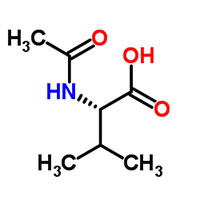Synonyms
(2S)-2-acetamido-3-methylbutanoic acid
Valine, N-acetyl-, L-
EINECS 202-537-8
MFCD00066066
DL-Valine, N-acetyl-
N-Acetyl-L-valine
L-Valine, N-acetyl-
Ac-Val-OH
Product Description
N-Acetyl-L-valine, commonly known as N-Acetylvaline or NAV, is a significant chemical compound with
diverse applications in the chemical industry. This product introduction aims to provide an overview of
N-Acetyl-L-valine, covering its raw materials, production process, market trends, and the current status
of amino acids in the industry.
Raw Materials:
N-Acetyl-L-valine is synthesized using L-valine and acetic anhydride as the primary raw materials.
L-valine, an essential amino acid, serves as the precursor for N-Acetyl-L-valine synthesis. Acetic
anhydride provides the acetyl group necessary for acetylation.
Production Process:
The production process of N-Acetyl-L-valine involves the following steps:
Step 1: Esterification reaction - L-valine is reacted with acetic anhydride in the presence of suitable
catalysts and reaction conditions to form N-Acetyl-L-valine. The reaction takes place in a solvent or
under solid-state conditions, depending on the specific manufacturing process.
Step 2: Purification and refinement - The resulting N-Acetyl-L-valine is purified and refined using
techniques such as filtration, crystallization, and chromatography to achieve the desired level of
purity.
Market Trends:
The market demand for N-Acetyl-L-valine has been steadily increasing due to its diverse applications
across various industries. Here are some key market trends:
Pharmaceuticals: N-Acetyl-L-valine is utilized in the pharmaceutical industry. It is used as an
ingredient in the formulation of drugs targeting neurological disorders, cognitive function, and muscle
health. It may also have applications in the development of sports nutrition products.
Food and Beverage: N-Acetyl-L-valine finds applications in the food and beverage industry. It is used as
a flavor enhancer and can contribute to the savory or umami taste in food products. It is particularly
used in savory snacks, seasonings, and ready-to-eat meals.
Chemical Research: N-Acetyl-L-valine serves as a valuable compound in chemical research. It is used as a
building block in the synthesis of peptides, pharmaceutical intermediates, and specialty chemicals. Its
unique structure and functional groups make it useful for diverse synthetic applications.
Current Status of Amino Acids:
Amino acids play a crucial role in various sectors, including pharmaceuticals, food additives, animal
nutrition, and agriculture. The demand for amino acids continues to grow due to their diverse
applications and essential role in biological processes. Essential amino acids, such as L-valine, are of
particular importance as they cannot be synthesized by the human body and must be obtained through diet
or supplementation.
Conclusion:
N-Acetyl-L-valine, derived from L-valine, holds significant value in the chemical industry. Its
production involves the combination of raw materials and precise manufacturing processes. The market
demand for N-Acetyl-L-valine is driven by its applications in pharmaceuticals, food and beverage, and
chemical research. Amino acids, including L-valine, continue to play a vital role in various industries,
and N-Acetyl-L-valine maintains its position as a valuable chemical compound with diverse
applications.





